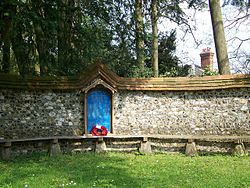Wilsford, Amesbury
| Wilsford | |
| Wiltshire | |
|---|---|
 War Memorial, Wilsford | |
| Location | |
| Grid reference: | SU135398 |
| Location: | 51°9’25"N, 1°48’32"W |
| Data | |
| Population: | 191 (2011) |
| Post town: | Salisbury |
| Postcode: | SP4 |
| Dialling code: | 01980 |
| Local Government | |
| Council: | Wiltshire |
| Parliamentary constituency: |
Salisbury |
Wilsford is a village in the Woodford valley in Wiltshire, within the green valley which the Salisbury Avon cuts through the rolling acres of Salisbury Plain. The village stands on the Avon's west bank, about two miles southwest of Amesbury and six miles north of Salisbury.
Along with the hamlet of Normanton to the north and Lake to the south, Wilsford forms a shared civil parish (Wilsford cum Lake) and is within a share ecclesiastical parish ('Woodford Valley with Archers Gate').
History
The parish is rich in archaeological features, and lies within the Stonehenge World Heritage Site. The scheduled monuments at Normanton Down include a Neolithic long barrow and some 40 Bronze Age round barrows.
Three estates were recorded in the Domesday Book of 1086, with 19 households.[1] A chapel at Lake belonged to Bradenstoke Priory in the early 12th century; it fell into disuse before the 16th century.[2] By the early 13th century, the two adjacent church parishes of Wilsford and Woodford supported a prebendary at Salisbury.
A small Church of England school was built at Wilsford in 1857, extended in 1915 and closed in 1960.[3]
Parish church
The parish church of St Michael is from the 12th century but was largely rebuilt in 1852 by Thomas Henry Wyatt. Wall monuments inside the church include an engraved slate tablet by Eric Gill. The church is Grade II* listed.[4][5]
About the village
Wilsford House, near the church, is also Grade II* listed. The house was built in 17th-century style by Detmar Blow in 1904-6 for Sir Edward Tennant, who was Member of Parliament for Salisbury from 1906 to 1910. The house was inherited by Sir Edward's son, Stephen Tennant, a leading member of the "Bright young things" social set.[6]
The author V. S. Naipaul rented a cottage in the grounds and much of his 1987 novel The Enigma of Arrival is based on the surrounding area.[7] Normanton Manor was the retirement home of Sir Oliver Lodge (1851-1940), the physicist and writer who was involved in the development of radio.
Outside links
| ("Wikimedia Commons" has material about Wilsford cum Lake) |
- "Wilsford cum Lake". Wiltshire Council. http://history.wiltshire.gov.uk/community/getcom.php?community=Wilsford%20Cum%20Lake. Retrieved 11 February 2016.
References
- ↑ Wilsford in the Domesday Book
- ↑ A History of the County of Wiltshire - Volume pp 213-221: {{{2}}} (Victoria County History): : Wilsford
- ↑ "Wilsford Church of England School". Wiltshire Council. http://history.wiltshire.gov.uk/community/getschool.php?id=1519. Retrieved 11 February 2016.
- ↑ National Heritage List 1284143: Church of St Michael
- ↑ "Church of St. Michael, Wilsford cum Lake". Wiltshire Council. http://history.wiltshire.gov.uk/community/getchurch.php?id=1582. Retrieved 10 February 2016.
- ↑ National Heritage List 1131008: Wilsford House
- ↑ "Wilsford cum Lake". Wiltshire Council. http://history.wiltshire.gov.uk/community/getcom.php?community=Wilsford%20Cum%20Lake. Retrieved 10 February 2016.